 |
| Florence travel guide, vacation in Florence, holiday in Florence, tour of Florence, tourism Florence, booking hotel in Florence, rent a car Florence, fly to Florence, Incoming Florence, Wedding in Florence, Weather Florence, Images Florence |
|
|
|
Florence
|
Florence (or Firenze, Florentia and Fiorenza) is the capital city of the Italian region of Tuscany, and of the province of Florence. It is the most populated city in Tuscany and has a population of approximately 364,779.
History
Florence was originally established by Julius Caesar in 59 BC as a settlement for his veteran soldiers. It was named Florentia (Flourishing) and built in the style of an army camp with the main streets, the cardo and the decumanus, intersecting at the present Piazza della Repubblica. Situated at the Via Cassia, the main route between Rome and the North, and within the fertile valley of the Arno, the settlement quickly became an important commercial center. Emperor Diocletian made Florentia capital of the province of Tuscia in the 3rd century AD.
Saint Minias was Florence’s first martyr. He was beheaded at about 250 AD, during the anti-Christian persecutions of the Emperor Decius. After being beheaded, it is said that he picked up his disembodied head and walked across the Arno River and up the hill Mons Fiorentinus to his hermitage, where the Basilica di San Miniato al Monte now stands.
The seat of a bishopric from around the beginning of the 4th century AD, the city experienced subsequent turbulent periods of Ostrogothic rule, during which the city was often troubled by warfare between the Ostrogoths and the Byzantines, which may have caused the population to fall to as few as 1,000 living persons.
Peace returned under Lombard rule in the 6th century. Conquered by Charlemagne in 774, Florence became part of the duchy of Tuscany, with Lucca as capital. Population began to grow again and commerce prospered. In 854, Florence and Fiesole were united in one county.
Margrave Hugo chose Florence as his residency instead of Lucca at about 1000 AD. This initiated the Golden Age of Florentine art. In 1013, construction began on the Basilica di San Miniato al Monte. The exterior of the baptistry was reworked in Romanesque style between 1059 and 1128.
the "David di Michelangelo"This period also saw the eclipse of Florence's formerly powerful rival Pisa (defeated by Genoa in 1284 and subjugated by Florence in 1406), and the exercise of power by the mercantile elite following an anti-aristocratic movement, led by Giano della Bella, that resulted in a set of laws called the Ordinances of Justice (1293).
Of a population estimated at 80,000 before the Black Death of 1348, about 25,000 are said to have been supported by the city's wool industry: in 1345 Florence was the scene of an attempted strike by wool combers (ciompi), who in 1378 rose up in a brief revolt against oligarchic rule in the Revolt of the Ciompi. After their suppression, Florence came under the sway (1382-1434) of the Albizzi family, bitter rivals of the Medici. Cosimo de' Medici was the first Medici family member to essentially control the city from behind the scenes. Although the city was technically a democracy of sorts, his power came from a vast patronage network along with his alliance to the new immigrants, the gente nuova. The fact that the Medici were bankers to the pope also contributed to their rise. Cosimo was succeeded by his son Piero, who was shortly thereafter succeeded by Cosimo's grandson, Lorenzo in 1469. Lorenzo was a great patron of the arts, commissioning works by Michelangelo, Leonardo da Vinci and Botticelli. Lorenzo was also an accomplished musician and brought some of the most famous composers and singers of the day to Florence, including Alexander Agricola, Johannes Ghiselin, and Heinrich Isaac. By contemporary Florentines, (and since), he was known as "Lorenzo the Magnificent" (Lorenzo il Magnifico).
Following the death of Lorenzo in 1492, he was succeeded by his son Piero II. When the French king Charles VIII invaded northern Italy, Piero II chose to resist his army. But when he realized the size of the French army at the gates of Pisa, he had to accept the humiliating conditions of the French king. These made the Florentines rebel and they expelled Piero II. With his exile in 1494, the first period of Medici rule ended with the restoration of a republican government.
During this period, the Dominican monk Girolamo Savonarola had become prior of the San Marco monastery in 1490. He was famed for his penitential sermons, lambasting what he viewed as widespread immorality and attachment to material riches. He blamed the exile of the Medicis as the work of God, punishing them for their decadence. He seized the opportunity to carry through political reforms leading to a more democratic rule. But when Savonarola publicly accused Pope Alexander VI of corruption, he was banned from speaking in public. When he broke this ban, he was excommunicated. The Florentines, tired of his extreme teachings, turned against him and arrested him. He was convicted as a heretic and burned at the stake on the Piazza della Signoria on 23 May 1498.
A second individual of unusual insight was Niccolò Machiavelli, whose prescriptions for Florence's regeneration under strong leadership have often been seen as a legitimisation of political expediency and even malpractice. Commissioned by the Medici, Machiavelli also wrote the Florentine Histories, the history of the city. Florentines drove out the Medici for a second time and re-established a republic on May 16, 1527. Restored twice with the support of both Emperor and Pope, the Medici in 1537 became hereditary dukes of Florence, and in 1569 Grand Dukes of Tuscany, ruling for two centuries. In all Tuscany, only the Republic of Lucca (later a Duchy) and the Principality of Piombino were independent from Florence.
The extinction of the Medici line and the accession in 1737 of Francis Stephen, duke of Lorraine and husband of Maria Theresa of Austria, led to Tuscany's temporary inclusion in the territories of the Austrian crown. It became a secundogeniture of the Habsburg-Lorraine dynasty, who were deposed for the Bourbon-Parma in 1801 (themselves deposed in 1807), restored at the Congress of Vienna; Tuscany became a province of the United Kingdom of Italy in 1861.
Florence replaced Turin as Italy's capital in 1865, hosting the country's first parliament, but was superseded by Rome six years later, after the withdrawal of the French troops made its addition to the kingdom possible. After doubling during the 19th century, Florence's population tripled in the 20th with the growth of tourism, trade, financial services and industry. During World War II the city experienced a year-long German occupation (1943-1944) and was declared an open city. The Allied soldiers who died driving the Germans from Tuscany are buried in cemeteries outside the city (Americans about 9 kilometres (6 mi) south of the city, British and Commonwealth soldiers a few kilometers east of the center on the north bank of the Arno)
A very important role is played in those years by the famous café of Florence Giubbe Rosse from its foundation until the present day. Piazza del Mercato Vecchio was destroyed (Old Market Square), and then was renamed Piazza Vittorio Emanuele II. It is known today as Piazza della Repubblica, and is the location of the Giubbe Rosse. In those years (the end of the l9th century) the city administration of Florence decided to raze the old neighborhood of Mercato Vecchio to the ground, in favour of a new square dedicated to Victor Emmanuel II. "Non fu giammai così nobil giardino/ come a quel tempo egli è Mercato Vecchio / che l'occhio e il gusto pasce al fiorentino", claimed Antonio Pucci (poet) in the fourteenth century, "Mercato Vecchio nel mondo è alimento./ A ogni altra piazza il prego serra". The area had decayed from its original medieval splendor". Nowadays the literary café Giubbe Rosse is publishing books of famous Italian authors such: Mario Luzi, Manlio Sgalambro, Giovanni Lista, Menotti Lerro, Leopoldo Paciscopi.
In November 1966, the Arno flooded parts of the center, damaging many art treasures. There was no warning from the authorities who knew the flood was coming, except a phone call to the jewelers on the Ponte Vecchio. Around the city there are tiny placards on the walls noting where the flood waters reached at their highest point.
Florence and the Renaissance
There was a surge in artistic, literary, and scientific activity in Florence from the 14th to 16th centuries. This was accompanied by significant economic growth and business activity. There was substantial private and public funding to sponsor artistic and scholarly endeavours.
There were crises in the Roman Catholic church (especially the controversy over the French Avignon Papacy and the Great Schism). There were catastrophic results from the Black Death and a some re-evaluation of medieval values.
|
Images Florence
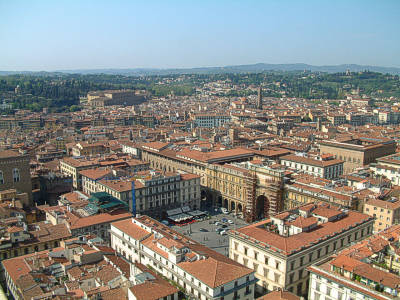
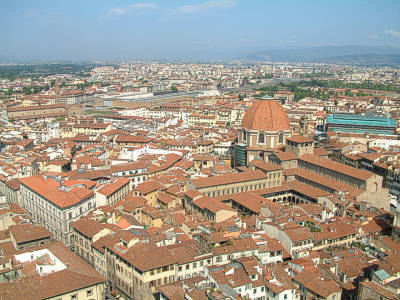
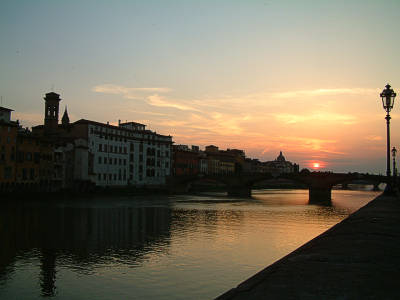
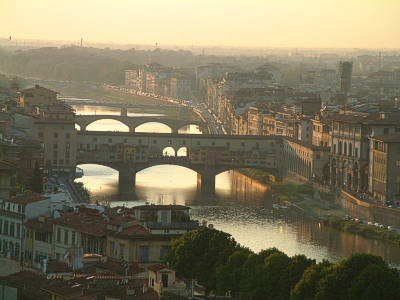
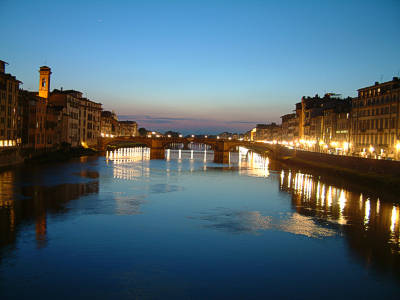
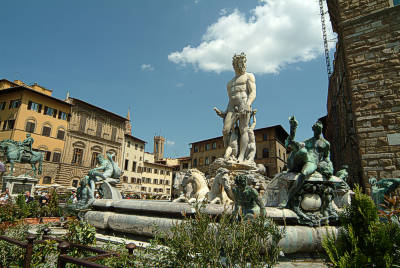
... more images of Florence
|
|
» Cerca Ospitalità in Florence
|
|
« Index Florence |
|
|
|
|
|
|
 |



